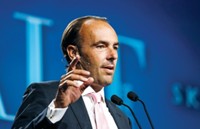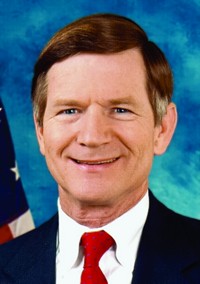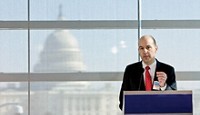Advertisement
Grab your lab coat. Let's get started
Welcome!
Welcome!
Create an account below to get 6 C&EN articles per month, receive newsletters and more - all free.
It seems this is your first time logging in online. Please enter the following information to continue.
As an ACS member you automatically get access to this site. All we need is few more details to create your reading experience.
Not you? Sign in with a different account.
Not you? Sign in with a different account.
ERROR 1
ERROR 1
ERROR 2
ERROR 2
ERROR 2
ERROR 2
ERROR 2
Password and Confirm password must match.
If you have an ACS member number, please enter it here so we can link this account to your membership. (optional)
ERROR 2
ACS values your privacy. By submitting your information, you are gaining access to C&EN and subscribing to our weekly newsletter. We use the information you provide to make your reading experience better, and we will never sell your data to third party members.
Policy
Patent Reform Prospects Cloudy
Critics worry changes would reduce investment, slow pace of innovation
by Glenn Hess
November 24, 2008
| A version of this story appeared in
Volume 86, Issue 47
PRESIDENT-ELECT Barack H. Obama's support for a number of tech-friendly initiatives, including reform of the decades-old U.S. patent system, translated into generous campaign contributions from Silicon Valley's technology companies.
The computer and Internet industry contributed five times as much to Obama's presidential campaign than to his Republican opponent Sen. John McCain's—$7.3 million compared with $1.4 million—according to the Center for Responsive Politics, a group that tracks money in politics. Overall, computer makers and software developers donated more than $19 million to Democratic candidates for federal office in the just-concluded 2007-08 election cycle, whereas Republicans received only about $11 million.
But whether the high-tech sectors' lopsided support for the newly elected president and the strengthened Democratic majorities on Capitol Hill can break the current legislative deadlock and push patent reform over the finish line in the upcoming 111th Congress is far from certain, intellectual property experts say.
"I'm not necessarily convinced that this is a partisan issue," says Philip G. Kiko, former general counsel and chief of staff of the House Judiciary Committee and currently an attorney in the Washington, D.C., office of law firm Foley & Lardner. "A lot of Democrats had concerns about how the bill in the last Congress would affect innovation and emerging industries," Kiko says. "I'm not convinced that just because you pour a lot of money into one side of the political aisle that it is going to guarantee an outcome. I would hope that's not the case."
Matthew P. Becker, an attorney in the Chicago office of Banner & Witcoff, agrees that the outcome of the election will not necessarily improve the chances of passing a patent reform bill in the next Congress. The effort to overhaul U.S. patent law for the first time in more than half a century is a "fairly complex, nonpartisan issue with strong lobbying groups on each side," he notes.
"It's basically been the high-tech and finance companies on one side and the biotech and pharmaceutical industries on the other. Members of Congress have companies on one side of the fence or the other in their states and districts, so the votes haven't broken down along party lines," Becker points out.
At issue is the Patent Reform Act of 2007 (H.R. 1908, S. 1145), which passed the House by a vote of 220-175 on Sept. 7, 2007, but died in the Senate last April when lawmakers and private-sector lobbyists could not agree on key provisions. The bill, which will undoubtedly be revived next year, is being pushed primarily by high-tech firms that want to curb the number of costly lawsuits they face and limit damage awards.
The legislation is designed to improve the quality of patents issued by the Patent & Trademark Office (PTO), allow for more rigorous reexamination of patents that may have been issued incorrectly, and change provisions in the existing law that encourage speculative patent infringement suits against good-faith innovators and manufacturers.
The bill would also allow courts to change the way they assess damages in infringement cases. Currently, courts generally consider the value of the entire product when a small piece of the product infringes a patent. The legislation would allow, but not require, courts to base damages only on the value of the infringing piece.
TECHNOLOGY COMPANIES such as Microsoft and Apple favor this approach. They say they have been hit by a flood of frivolous suits brought by "patent trolls," people who take out patents on products, methods, or ideas so they can sue a company for infringement if it eventually rolls out a product that incorporates the patented material. Makers of computers and other electronics are particularly vulnerable because their products often contain hundreds if not thousands of linked patented components, and any one of them could spark a legal battle.
According to research by James Bessen and Michael J. Meurer of Boston University School of Law, 2,830 patent lawsuits were filed in U.S. district courts in 2006, up from 1,840 in 1996 and 1,129 in 1986.
"The high-tech world has been the target of a lot of patent litigation by individual inventors," Becker says. "That's not really a problem for the pharma, biotech, and chemical areas. Those companies make a lot of investments in research and development of new products, and it takes a lot of money to patent these products as well. They favor the current system, which makes it difficult to invalidate a patent. And because of the great investment they make, they want to make sure they will receive substantial damages if litigation determines that there has been infringement."
In fact, biotechnology and pharmaceutical companies, which depend on strong patent protections to justify their investment in the lengthy and expensive drug development process, argue that the proposed changes would ultimately reduce the value of their intellectual property and thus undermine innovation.
"We must maintain strong protections for intellectual property—the key to an innovation economy—while enhancing patent quality and the objectivity, predictability, and transparency of the patent system," says James C. Greenwood, president of the 1,200-member Biotechnology Industry Organization (BIO).
Greenwood points out that most biotech companies do not yet have products on the market. "They do, however, have innovative ideas that are protected by patents," he says. "Our members rely on the strength and predictability of their patents to generate the massive investment needed to bring these ideas and technologies to life."
Critics of the existing system say PTO has been overwhelmed by a huge increase in applications in recent years, particularly from the information technology sector. Fiscal 2007 saw 468,330 applications submitted, compared with 237,045 in fiscal 1997 and 137,173 in fiscal 1987. PTO had a backlog of nearly 761,000 applications at the end of fiscal 2007, with applicants waiting an average of two years and eight months for a final decision.
FOR PTO to issue a patent, the invention must be novel, nonobvious, and useful. But Aparna Mathur, a research fellow in economics policy at the American Enterprise Institute, a Washington, D.C., think tank, says the main problem with the patent system is that the overburdened office has been issuing too many dubious patents.
Although a "bad" patent can be challenged through a reexamination proceeding at PTO, Mathur says, the process has been criticized for being biased in favor of the patent owner, and only 10% of reexaminations result in revocation. Litigation is more effective, she says, but it's also much more expensive.
In an effort to more effectively ensure that patents are issued for truly innovative and novel ideas, the reform bill would allow patents to be challenged after they are issued through a new "postgrant opposition" proceeding. Proponents claim this third method would be more effective at invalidating low-quality patents and would also reduce the amount of patent litigation.
But Mathur says an analysis she coauthored with economist Robert J. Shapiro indicates that the costs of an opposition proceeding would far outweigh its benefits. "The demand for lawyers and paperwork would drive up costs and make the opposition proceeding extremely expensive," she says.
Mathur and Shapiro's cost-benefit analysis found that adopting an opposition system would increase the private-sector costs of adjudicating patents by nearly $16 billion over 10 years.
At the same time, Mathur adds, a broad and open-ended postgrant opposition system could discourage innovation by increasing investor uncertainties about patent rights. "An opposition regime could significantly reduce investment in R&D and slow the pace of innovation," she says. "Unfortunately, the proposed reforms would do more harm than good."
BIO's Greenwood says the study confirms his industry's view that the Patent Reform Act of 2007 would make it easier to challenge patents and harder to enforce them. Although "a limited postgrant opposition system may make sense, the costs and risks of a broad new challenge system are too high for Congress to ignore," he says.
Looking ahead, Harold C. Wegner, a partner at Foley & Lardner and a professor at George Washington University Law School, says that without strong leadership from the Obama Administration, no realistic opportunity exists for patent reform in the next Congress. The next PTO director "must create a middle-ground patent reform proposal that is acceptable to both" sides in the debate, Wegner says.
During his presidential campaign, Obama did call for patent reform as part of his technology policy platform. But his plans are vague and primarily consist of providing PTO with more resources. In a position paper that addresses a range of technology issues, the president-elect pledges to ensure that the nation's patent laws protect legitimate rights while not stifling innovation.
"By improving predictability and clarity in our patent system, we will help foster an environment that encourages innovation," Obama states in the position paper. "Giving PTO the resources to improve patent quality and opening up the patent process to citizen review will reduce the uncertainty and wasteful litigation that is currently a significant drag on innovation.
"With better informational resources, PTO could offer patent applicants who know they have significant inventions the option of a rigorous and public peer review that would produce a 'gold plated' patent much less vulnerable to court challenge," Obama adds. "Where dubious patents are being asserted, PTO could conduct low-cost, timely administrative proceedings to determine patent validity."
Obama's statements about the need for patent reform have been "fairly broad, and of course, the devil is always in the details," Kiko remarks. He also says it's unknown how important patent reform will be in the new Administration.
Becker agrees that Obama's stance on the issue is unclear. "Certainly, if the President comes on board and pushes one side of the issue, then the rest of the Democrats will probably fall in line to the extent that they can," he remarks. "But I suspect that President-Elect Obama won't necessarily take a position because he has a lot of other issues much higher on his priority list than patent reform."
The debate in Congress has focused on the high-tech-friendly version of the patent reform legislation, but lawmakers in the next session will also consider an alternative plan (S. 3600) that was offered in late September by Sen. John Kyl (R-Ariz.). The legislation, which is favored by the biotech and pharma sectors, would require litigants to present precise economic analyses to determine damages and would limit the time and scope of postgrant reviews of patent applications.
Greenwood says the legislation is a "vast improvement" over previous patent reform bills considered by Congress. "In particular," he notes, "the Kyl legislation advances the debate on damages in a positive direction by enhancing consistent enforcement of the current law on damages and providing greater predictability for companies across all industries—but without manipulating the rules to favor infringers."
In addition, Greenwood says, the postgrant review provisions in the Kyl bill would provide a "second window" to administratively challenge a patent, but the circumstances allowing such a challenge are considerably narrower than those in the Patent Reform Act of 2007. "The broad new administrative challenge system in S. 1145 would create patent uncertainty and reduce investment interest in biotechnology innovation," he contends.
But according to a statement from the Coalition for Patent Fairness, which represents companies such as Microsoft, Hewlett-Packard, and Dell, Kyl's legislation "will not fix the nation's patent system, which is broken and draining critical resources from healthy sectors of our economy."
The coalition, which insists that reform legislation must include provisions for apportioning damages in patent lawsuits, says Kyl's proposal "stops short of the necessary changes to address two critical issues: the flawed system for valuing patents and the approval of poor-quality patents."
NOTING THAT all of the players generally agree that a thorough initial review of patent applications by PTO benefits the patent system, Becker sees room for compromise. "The biotech and pharma groups would like to put more emphasis on getting the review done properly while the application is in the office and then not have the postgrant procedure for opposing patents. I think there is some middle ground there in which the parties could come together," he says.
Advertisement
But Becker also notes that the thorniest issue to resolve is how to calculate damages. "That was the stumbling block in the Senate this year, and it will still likely be the most difficult issue to resolve," he says.
Part of the problem, Becker adds, is that "no one knows what the proposed changes would truly mean. People are accustomed to what they know, and they can work within the existing system. The uncertainty of the future, I think, adds to the complexity."
Kiko says both sides in the debate have staked out their positions. "But for this to go forward, it has to be a win-win situation for everybody," he points out. "Neither side will get everything it wants, but you can't have one side convinced that this is going to hurt them," he says.
"This is too big of an issue" to just push through, Kiko adds. "You don't want to have an outcome where 10 years later you regret what you did."








Join the conversation
Contact the reporter
Submit a Letter to the Editor for publication
Engage with us on Twitter